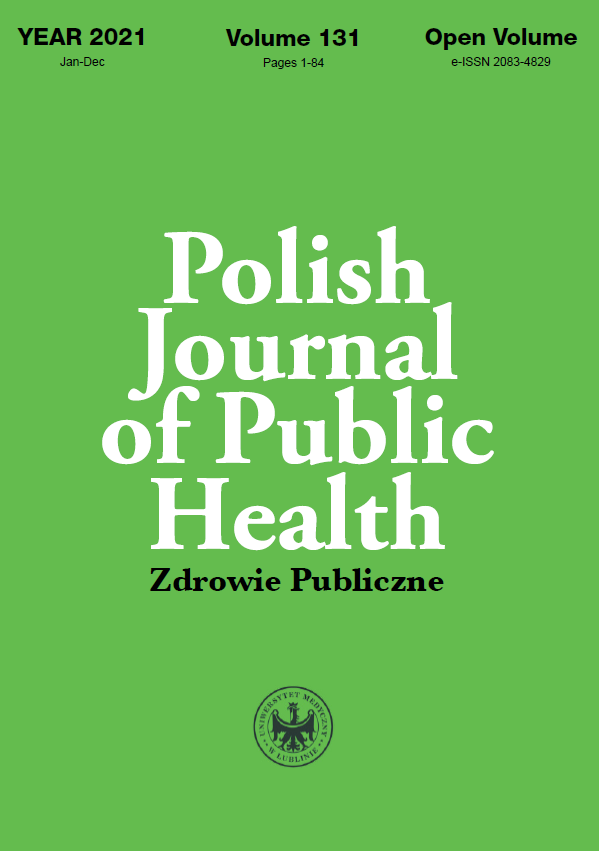The concentration-response functions for short-term exposure to ambient air pollution
DOI:
https://doi.org/10.2478/pjph-2021-0002Keywords:
concentration, exposure, function, logistic function, mortality, risk, transformationAbstract
Introduction. There are a few statistical approaches to estimate health impacts of the ambient air pollution concentrations. Air health effects are often studied in short-term exposure. In this context two main techniques are used; time-series and casecrossover (CC). This work focuses on the CC methodology. In the standard method risk is estimated using log-linear models.
Aim. This work proposes other types of the models.
Material and methods. The CC design is applied with various transformations of air pollution concentration. The mortality data are used for the period from 1987 to 2015 for Toronto, Canada. Daily concentration level of ambient ozone is considered as an exposure. The ozone concentration is transformed and used in the statistical models. The transformation is a product of two parts; a simple function such as logarithm and a logistic function as a weight. The transformed concentration is used in the CC statistical models. The models estimate the coefficient related to transformed concentration. It allows to construct the concentration response function. The generated models are assessed using the Akaike information criterion (AIC).
Results. The relative risks (RR), reported at 75th percentile of the concentration (55 ppb) are different. The standard CC model gives RR=1.0195 with the 95% confidence interval (1.0035, 1.0358), whereas the model with the transformation gives better fit and estimates RR=1.0054 (1.0026, 1.0082).
Conclusions. The proposed methodology allows to construct an accurate approximation of the concentration-response functions. These functions provide adequate approximations and also identify a potential threshold.
References
1. Ren M, Fang X, Li M, et al. Concentration-response relationship between PM2.5 and daily respiratory deaths in China: A systematic review and metaregression analysis of time-series studies. Biomed Res Int. 2017;2017:5806185.
2. Hoek G, Boogaard H, Knol A, et al. Concentration response functions for ultrafine particles and all-cause mortality and hospital admissions: results of a European expert panel elicitation. Environ Sci Technol. 2010;44(1):476-82.
3. Pope CA 3rd, Cropper M, Coggins J, Cohen A. Health benefits of air pollution abatement policy: Role of the shape of the concentration-response function. J Air Waste Manag Assoc. 2015;65(5):516-22.
4. Atkinson RW, Yu D, Armstrong BG, et al. Concentration-response function for ozone and daily mortality: results from five urban and five rural U.K. populations. Environ Health Perspect. 2012;120(10):1411-7.
5. Yan M, Wilson A, Bell ML, et al. The shape of the concentration-response association between fine particulate matter pollution and human mortality in Beijing, China, and its implications for health impact assessment. Environ Health Perspect.2019;127(6):67007.
6. Nasari MM, Szyszkowicz M, Chen H, et al. A class of non-linear exposure-response models suitable for health impact assessment applicable to large cohort studies of ambient air pollution. Air Qual Atmos Health. 2016;9:961-72.
7. Vicedo-Cabrera AM, Sera F, Liu C, et al. Short term association between ozone and mortality: global two stage time series study in 406 locations in 20 countries. BMJ. 2020;368:m108.
8. Maclure M. The case-crossover design: a method for studying transient effects on the risk of acute events. Am J Epidemiol. 1991;133(2):144-53.
9. Janes H, Sheppard L, Lumley T. Case-crossover analyses of air pollution exposure data: referent selection strategies and their implications for bias. Epidemiology. 2005;16:717-26.
10. Armstrong BG, Gasparrini A, Tobias A. Conditional Poisson models: A flexible alternative to conditional logistic case cross-over analysis. BMC Med Res Methodol. 2014;14:122.
11. Szyszkowicz M. Use of generalized linear mixed models to examine the association between air pollution and health outcomes. Int J Occup Med Environ Health. 2006;19:224-7.
12. Szyszkowicz M. Case-crossover method with a short time-window. Int J Environ Res Public Health. 2019;17(1):202.
13. Szyszkowicz M. Use of two-point models in “Model choice in time-series studies of air pollution and mortality”. Air Qual Atmos Health. 2020;13:225-32.
14. R Core Team. R: A language and environment for statistical computing. R Foundation for Statistical Computing. Vienna, Austria; 2020.
15. Szyszkowicz M. Concentration-response functions for short-term exposure and air pollution health effects. Environ Epidemiol. 2018;2(2):e011.
16. Turner H, Firth D. Generalized nonlinear models in R: An overview of the gnm package. (R package version 1.1-1). 2020. [http://CRAN.R-project.org/package=gnm]
17. David M. Gay DM. Usage summary for selected optimization routines. Computing Science Technical Report 153, AT&T Bell Laboratories, Murray Hill; 1990.
Downloads
Published
Issue
Section
License
Copyright (c) 2021 Polish Journal of Public Health

This work is licensed under a Creative Commons Attribution-NonCommercial-NoDerivatives 3.0 Unported License.


